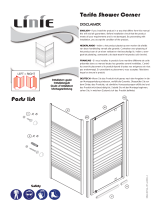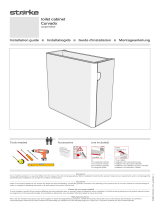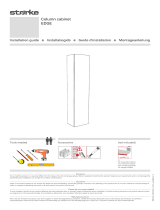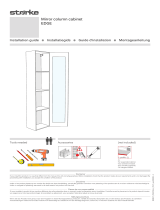Page is loading ...

Anleitungen Unterflurantrieb
Instructions Automatisme enterré pour portail
à battants
Instructions Underground gate actuator
Instrukties Ondergrondse aandrijving
D
F
GB
NL
Für Service: (49) 6838/907-172
Pour Service: 03-87-98-15-93
For Service: 0800-31-78-47
Voor Service: 020-684-7978
D
F
GB
NL
UGO300M
UGO300B

GB-1
START BY READING THESE IMPORTANT SAFETY RULES
Handle tools and hardware carefully and do not
wear rings, watches or loose clothing while
installing or servicing a gate opener.
Installation and wiring must be in compliance with
your local building and electrical codes. Connect
the power cord only to properly earthed mains.
Disconnect electric power to the gate opener
before making repairs.
Disengage all existing gate locks to avoid damage
to gate opener.
Keep gate balanced. Sticking or binding gates must
be repaired. Do not attempt to repair the gates
yourself. Call for service.
Keep additional accessories out of the reach of
children. Do not allow children to operate push
button(s) or remote control(s). Serious personal
injury from a closing gate may result from misuse of
the opener.
Ensure that persons who install, maintain or
operate the gate opener follow these instructions.
Keep this manual where it can be readily
referenced during maintenance.
These safety alert symbols mean Caution – a personal safety or property damage instruction. Read these
instructions carefully.
This gate opener is designed and tested to offer reasonable safe service provided it is installed and operated
in strict accordance with the following safety rules.
Failure to comply with the following instructions may result in serious personal injury or property damage.
Contents:
Safety Rules: Page 1
Technical data: Page 1
Warranty: Page 1
Contents of the carton: Page 2
Before you begin: Page 2
Installation of the unit: Page 2, Figure -
Electrical connections: Page 2, Figure
Safety: Page 3
Check on operation: Page 3
Final remarks: Page 3
Accessories: Page 3, Figure
12
10
91
TECHNICAL DATA
WARRANTY
LIFTMASTER warrants to the first retail purchaser of this product
that the product shall be free from any defect in materials and/or
workmanship for a period of 24 full months (2 years) from the date
of purchase for the Wing Gate Openers. Upon receipt of the product,
the first retail purchaser is under obligation to check the product for
any visible defects.
Conditions: The warranty is strictly limited to the reparation or
replacement of the parts of this product which are found to be
defective and does not cover the costs or risks of transportation of
the defective parts or product.
This warranty does not cover non-defect damage caused by
unreasonable use (including use not in complete accordance with
LIFTMASTER's instructions for installation, operation and care;
failure to provide necessary maintenance and adjustment, or any
adaptations of or alterations to the products), labor charges for
dismantling or reinstalling of a repaired or replaced unit or
replacement batteries.
A product under warranty which is determined to be defective in
materials and/or workmanship will be repaired or replaced (at
LIFTMASTER's option) at no cost to the owner for the repair and/or
replacement parts and/or product. Defective parts will be repaired or
replaced with new or factory rebuilt parts at LIFTMASTER's option.
This warranty does not affect the purchaser's statutory rights under
applicable national legislation in force nor the purchaser's rights
against the retailer arising from their sales/purchase contract. In the
absence of applicable national or EC legislation, this warranty will be
the purchaser's sole and exclusive remedy and neither LIFTMASTER
nor its affiliates or distributors shall be liable for any incidental or
consequential damages for any express or implied warranty relating
to this product.
No representative or person is authorized to assume for LIFTMASTER
any other liability in connection with the sale of this product.
Power supply
Capacitor
Current rating
Power rating
Max. opening angle
Max. duty cycle
Motor protection
Weight of the motor
Dimensions/Box
Max. size of the door
Weight of the door
Transmission ratio
Protection
Operating Temp.
UGO300
230V-240V/50-60Hz
12yF
1,3A
190W
120
O
50% / hr.
135 °C
10kg
160x380x320
3,0m
300kg
1:1120
IP 56
-35
o
to + 80
o

CONTENTS OF THE CARTON
• Unit (1)
• Hardwarebag (1)
• Manual (1)
• Key for switch to manual operation (1)
• Capacitor 12yF (1)
BEFORE YOU BEGIN
Planning and precision are vital for the
mounting of an underground opener, in order to
ensure that unforeseen circumstances do not
limit or prevent proper operation later.
Adequate drainage facilities are essential to avoid
malfunction.
♦ Size of gate: The size of the gate is one very important
factor. Wind can slow the gate down or distort it, causing a
marked increase in the force required to move it.
♦ Weight of gate: The specified weight of the gate only gives
a rough indication of the output required from the drive. The
function which the gate is expected to perform is also
important in this connection.
♦ Temperature: Low outdoor temperatures can make it more
difficult or impossible to set the gate into motion (e.g.
because of soil changes).
High outdoor temperatures may cause the temperature cut-
off (at about 135 °C) to be triggered earlier.
♦ Operating frequency, duty cycle: The actuator has a
maximum duty cycle of 50% (e.g. 50% of one hour).
PREPARATIONS
Before installation, please check contents of packaging.
Please remember that you will require some additional
material not included in the assembly kit delivered, such as
empty piping, cables, screws, plugs, etc. In order to avoid
undesirable oscillation, the wing should be stable and the
hinges should have as little play as possible. The more easily
the gate moves, the finer should the force adjustment be
made. Low-rigidity wooden gates should be reinforced with a
metal frame.
INSTALLATION OF THE UNIT -
1. The gate, and the arm, pivot about a point on the motor
housing (see Fig. 1-4). Mount the arm to which the gate
will be welded later; do not forget to place the ball in the
bearing.
2. Check the overall dimensions to ensure that you will have
enough room to dig out a hole for the motor housing. The
opening angle of the gate has an important influence on
the position of the motor housing (see Fig. 5-7).
The motor housing must be set in concrete. The piping for
the electrical wiring and the drainage should be borne in
mind in this connection (see Fig. 10). Remember that the
final dimensions of the installation (including plaster layer
etc.) determine the room available. The top of the motor
housing should be slightly higher than the concrete
surrounding it.
The concrete takes a couple of days to set completely.
You should aim at a strength rating of at least MG2a
according to DIN standards (normal strength).
3. Once the motor housing has been set in place, the gate
can be mounted on top of it. Additional hinges will certainly
be needed to ensure proper guidance.
4. The arm with the facilities for switching to manual
operation must be welded on to the gate. Turning the
special key in the hole provided for it switches the system
to manual operation so that the gate can be opened by
hand if necessary (see Fig. 1 and 8).
5. Stops must be mounted on the floor to limit the limit the
motion of the gate (see Fig. 9).
6. After all assembly work has been completed, it is advisable
to protect the motor housing against seepage of water with
the aid of a layer of silicone sealant.
TIPS FOR DRAINAGE A and B
If the drainage of the installation cannot be connected up to
the main drains, it may be possible to make use of a drainage
pit. The floor must be permeable to water, and the cover of
the motor housing should be protected against heavy rainfall
or surface water with silicone sealant. The drainage pit should
be dug out so as to be appreciably lower than the bottom of
the motor housing, and its capacity should exceed that of the
motor housing. The pit should be filled with coarse rubble or
gravel, and should be tiled to keep out sediment and water
from the top and sides. Facilities should be provided to lead
any water getting into the motor housing to this drainage pit.
ELECTRICAL CONNECTIONS
We recommend use of the control unit GOC1A
The coding of the connection terminals is as follows
N= neutral (blue)
L1= black – On or Off (change over if necessary)
L1= brown – On or Off (change over if necessary)
Do not forget to earth the system!
The capacitor must be connected between L1 and L2
(black and brown wires) in the control circuit, and must
be protected against water.
11
10
91
GB-2

GB-3
CHECK ON OPERATION
Activate the function "Automatic close” on the control unit. If
the gate opens automatically after the preset time, exchange
the brown and black leads.
Most control units have a time function. This should always
be set to about 3 - 5 seconds more than the time actually
required. The preliminary setting should be made somewhat
more than this, to allow a safety margin; after the necessary
adjustments to the system have been made, the time can be
set more accurately. NB: The drive works more slowly
under windy conditions.
SAFETY MEASURES
An automatically operated wing gate should always
be further protected with the aid of flashing lights,
contact strips and photoelectric barriers. In any
case, take care to comply with the relevant
standards and regulations.
FINAL REMARKS
Arrange the handover of the wing gate opener with your
customer Make sure that persons will operate the gate are
familiar with its functions and can operate them without
problems. Have your customer practice operating the gate
until he is fully acquainted with all the following:
• Main switch.
• Rules of operation (e.g. do not drive through while the gate
is still opening).
• Additional safety features (photoelectric barrier, contact
strip, flashing lights, etc.).
• Switch to manual operation in case of power failure.
• Provide the customer with a full set of instructions. Inform
him to keep them in a safe place and read them when
possible.
• Reference a checklist, so that you have a record of
which functions have been explained and of any points not
dealt with.
ACCESSORIES
(1) Model FLA230-2 Flashing Light
(2) Model 100263 Infrared barrier
(3) Model 100027 1-Function Keyswitch,
surface mount
(Flush mount - 100010)
Model 100041 2-Function Keyswitch,
surface mount
(Flush mount - 100034)
(4) Model 600046 2.5 Safety Edge Set (Small)
(5) Model 600053 20m Bulk Pack Safety Edge
Profile (Small)
(6) Model 600060 Assembly Pack Safety Edge
(Small)
(7) Model 600152 Assembly Pack Safety Edge
(Medium/Large)
(8) Model 600077 Bulk pack (not shown)
(9) Model 600145 20m Bulk Pack Safety Edge
Profile (Large) (not shown)
(10) Model 600138 20m Bulk Pack Safety Edge
Profile (Medium) (not shown)
(11) Model 600176 1m Safety Edge Profile (Large)
(not shown)
(12) Model 600169 1m Safety Edge Profile (Medium)
(not shown)
(13) Model 600008 IR Sensor Stand - 530mm
(14) Model 600015 Key Switch Stand - 1100mm
12
709154 © Chamberlain GmbH, 2000

Declaration of Conformity
Automatic Gate Opener ..........................................................................................Model UGO300
is in conformity to the applicable sections of Standards..............................EN55014, EN61000-3,
EN60555, EN60335-1, & ETS 300 683
per the provisions & all amendments of the EU Directives .......................73/23/EEC, 89/336EEC
Declaration of Incorporation
Automatic Gate Opener Models UGO300, when installed and maintained
according to all the Manufacturer’s instructions in combination with a Gate Door,
which has also been installed and maintained according to all the Manufacturer’s
instructions, meets the provisions of EU Directive 89/392/EEC and all amendments.
I, the undersigned, hereby declare that the equipment
specified above and any accessory listed in the manual
conforms to the above Directives and Standards.
Chamberlain GmbH
D-66793 Saarwellingen
November, 2000
EG-Konformitätserklärung
Der automatische Torantrieb ...............................................................................Modell Nr. UG300
erfüllt alle Bedingungen der
Richtlinien ....................................................................................................EN55014, EN61000-3,
............................................................................................ETS 300 683, EN60555, & EN60335-1
sowie die Zusätze .....................................................................................73/23/EEC, 89/336/EEC
Integrationserklärung
Der automatische Torantrieb Modell UGO300 erfüllt, wenn er in Verbindung mit einem
Garagentor gemäß Herstelleranweisungen installiert und instandgehalten wird, alle
Bedingungen der EU-Richtlinie 89/392/EEC und deren Zusätze.
Ich, der Unterzeichner, erkläre hiermit, daß das vorstehend
genannte Gerät und das in der Montageanleitung aufgeführte
Zubehör, die vorstehenden Vorschriften und Richtlinien erfüllt.
Chamberlain GmbH
D-66793 Saarwellingen
November, 2000
Colin B. Willmott
Chefingenieur
Colin B. Willmott
Chefingenieur
/








